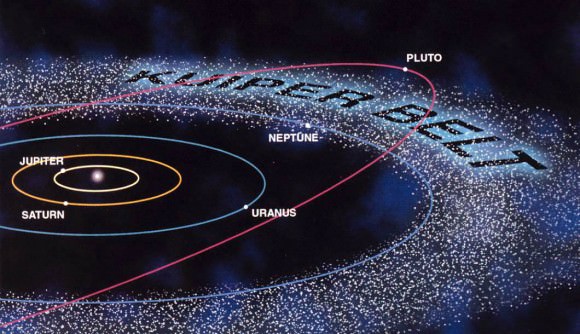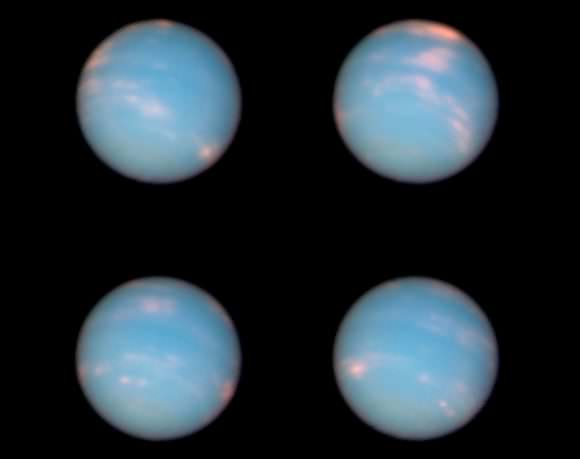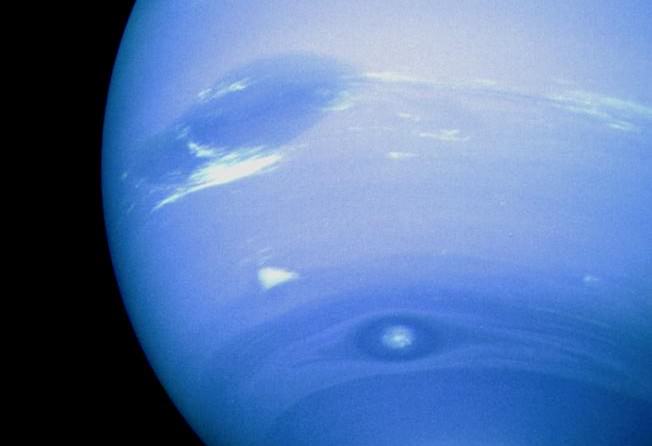Our Solar System is a fascinating place. Between its eight planets and many dwarf planets, there are some serious differences in terms of orbit, composition, and temperature. Whereas conditions within the inner Solar System, where planets are terrestrial in nature, can get pretty hot, planets that orbit beyond the Frost Line – where it is cold enough that volatiles (i.e. water, ammonia, methane, CO and CO²) condense into solids – can get mighty cold!
It is in this environment that we find Neptune, the Solar System’s most distance (and hence most cold) planet. While this gas/ice giant has no “surface” to speak of, Earth-based research and flybys have been conducted that have managed to obtain accurate measurements of the temperature in the planet’s upper atmosphere. All told, the planet experiences temperatures that range from approximately 55 K (-218 °C; -360 °F) to 72 K (-200 °C; -328 °F), making it the coldest planet in the Solar System.
Orbital Characteristics:
Of all the planets in the Solar System, Neptune orbits the Sun at the greatest average distance. With a very minor eccentricity (0.0086), it orbits the Sun at an semi-major axis of approximately 30.11 AU (4,504,450,000,000 km), ranging from 29.81 AU (4.459 x 109 km) at perihelion and 30.33 AU (4.537 x 109 km) at aphelion.

Neptune takes 16 hours 6 minutes and 36 seconds (0.6713 days) to complete a single sidereal rotation, and 164.8 Earth years to complete a single orbit around the Sun. This means that a single day lasts 67% as long on Neptune, whereas a year is the equivalent of approximately 60,190 Earth days (or 89,666 Neptunian days).
Because Neptune’s axial tilt (28.32°) is similar to that of Earth (~23°) and Mars (~25°), the planet experiences similar seasonal changes. Combined with its long orbital period, this means that the seasons last for forty Earth years. In addition, the planets axial tilt also leads to variations in the length of its day, as well as variations in temperature between the northern and southern hemispheres (see below).
“Surface” Temperature:
Due to their composition, determining a surface temperature on gas or ice giants (compared to terrestrial planets or moons) is technically impossible. As a result, astronomers have relied on measurements obtained at altitudes where the atmospheric pressure is equal to 1 bar (or 100 kilo Pascals), the equivalent of air pressure here on Earth at sea level.

It is here on Neptune, just below the upper level clouds, that pressures reach between 1 and 5 bars (100 – 500 kPa). It is also at this level that temperatures reach their recorded high of 72 K (-201.15 °C; -330 °F). At this temperature, conditions are suitable for methane to condense, and clouds of ammonia and hydrogen sulfide are thought to form (which is what gives Neptune its characteristically dark cyan coloring).
But as with all gas and ice giants, temperatures vary on Neptune due to depth and pressure. In short, the deeper one goes into Neptune, the hotter it becomes. At its core, Neptune reaches temperatures of up to 7273 K (7000 °C; 12632 °F), which is comparable to the surface of the Sun. The huge temperature differences between Neptune’s center and its surface create huge wind storms, which can reach as high as 2,100 km/hour, making them the fastest in the Solar System.
Temperature Anomalies and Variations:
Whereas Neptune averages the coldest temperatures in the Solar System, a strange anomaly is the planet’s south pole. Here, it is 10 degrees K warmer than the rest of planet. This “hot spot” occurs because Neptune’s south pole is currently exposed to the Sun. As Neptune continues its journey around the Sun, the position of the poles will reverse. Then the northern pole will become the warmer one, and the south pole will cool down.
Neptune’s more varied weather when compared to Uranus is due in part to its higher internal heating, which is particularly perplexing for scientists. Despite the fact that Neptune is located over 50% further from the Sun than Uranus, and receives only 40% its amount of sunlight, the two planets’ surface temperatures are roughly equal.

Deeper inside the layers of gas, the temperature rises steadily. This is consistent with Uranus, but oddly enough, the discrepancy is larger. Uranus only radiates 1.1 times as much energy as it receives from the Sun, whereas Neptune radiates about 2.61 times as much. Neptune is the farthest planet from the Sun, yet its internal energy is sufficient to drive the fastest planetary winds seen in the Solar System. The mechanism for this remains unknown.
And while temperatures on Pluto have been recorded as reaching lower – down to 33 K (-240 °C; -400 °F) – Pluto’s status as a dwarf planet mean that it is no longer in the same class as the others. As such, Neptune remains the coldest planet of the eight.
We have written many articles about Neptune here at Universe Today. Here’s The Gas (and Ice) Giant Neptune, What is the Surface of Neptune Like?, 10 Interesting Facts About Neptune, and The Rings of Neptune.
If you’d like more information on Neptune, take a look at Hubblesite’s News Releases about Neptune, and here’s a link to NASA’s Solar System Exploration Guide to Neptune.
We have recorded an entire episode of Astronomy Cast just about Neptune. You can listen to it here, Episode 63: Neptune.


uranus can be very itchy. maybe u have worms? I pull my trousers right up to my neck when I do sky at night.
ThAnK yOu to all the people that write this article because now i know more about neptune!!!
Can you pls.write more article about the planets because i’m enjoying reading a article about the planets!!!
Seems like it’s almost in the “Goldie Locks” zone! Imagine 40 years of summer! That’s a lot of lemonade!
Imagine -203.15 c? That’s not quite the lemonade summer you were thinking about, is it?
Sweatshirt weather. I love it.
An incomplete article due to the following facts — 1) Neptune’s stratosphere is at least 30 degree hotter than Uranus; 2) Neptune has a great internal heat source compared with that of Uranus, i.e., it releases more heat than receiving from the sun.
sang: All the planets give off more heat than they receive from the sun. Think about it: the heat the release will be equal to one solar input (whatever that happens to be for that planet), + whatever internal heat they’re releasing.
Why don’t they ask what the internal heating is from? I really wan’t to hear this explanation… 😉
@The One — Gravity.
Friction
I really get tired of articles that use everything except the english system. Kilometers, celsius, kelvin, all those scales are meaningless. If you’re going to publish articles in the U.S. at least include english system measurements on every numerical data you list. Sheeesh.
Yeah. I mean, we’d hate for the 4% of the world’s population backwoodsie enough to still use outdated units to be inconvenienced. Or they could, you know. Learn.
I wonder if he knows that American scientists who work in the fields covered on this site also use the metric system.
Its not the “English system”, it’s the Imperial system. And the metric system is used by every country in the world except for the US, Myanmar and Liberia. It is hardly meaningless, it is in fact, just shy of universal.
Except, this article is published primary for readers in the US correct? Most of the readers are people who weren’t taught to use that system, correct?
I agree firmly with the OP. It’s not our fault that we were not taught to use the metric system. Yes; it makes more sense; yes it’s a better system; our government and education system has decided we shall not use it.
For better or worse, we have spent our entire lives driving miles, measuring in inches and feet, and weighing in pounds, because that’s what we were told to do.
Your obvious and purposeful omission of these units – included by most, or all, of UT’s other writers – is frustrating to someone who pays monthly to support this site, but to whom seeing your name at the top of an article means either needing to skip it, look up conversions and use a calculator, or ignore some of the most fascinating parts of your pieces.
Illegal? Nope. Unprofessional? That’s for readers to decide. I’ll tell you one thing though: space journalism is supposed to be about making science accessible to the “masses”; the everyday people; the non-scientists among us, and there’s well over 300 million people to whom your articles are not accessible.
(Cont)
Cosmological/Astronomical numbers are hard enough to wrap the human mind around anyway, purposefully omitting the only units that a substantial portion of your reader base has no real life experience with which to imagine these scales, then further minimising them by posting a comment which I personally took to mean “you’re so small a group as to be insignificant and not worth my time”, might not be the best way to bring science to the masses.
I’m not your boss, nor can I tell you how to do your job. I can tell you though, for what it’s worth (which I understand may be nothing), that a good percentage of readers, representing – at a minimum – hundreds of people, don’t find your writings accessible, and aren’t learning the metric system just so we can read them.
This site is published for all English-language readers. SWhile most of our readers reside in the US, the metric system is used for all scientific measurements, hence why we rely on it. Second, we regularly include imperial conversions in our articles. But at times, we don’t always remember since (as I said) the metric system is used universally for the sake of scientific research. At no point do we “purposefully” omit things.
Last, this site is free, so therefore no one is “paying monthly” to use it. I don’t know where you drew that ocnclusion from, but its completely false. All the malformation we provide is given free of charge, so you are therefore not entitled to a level of service in exchange for your money. And if people like yourself find it frustrating, you yourself are capable of using a calculator and consulting a conversion table, yes?
Why not? The values are just as meaningless regardless of the units, relatively speaking. For example, referring to the core temperatures, you would be lying if you said that 12,632 degrees F is any more meaningful to you than 7,000 degrees C. You have no frame of reference for numbers that large, when it comes to temperature, other than “really really hot.”
Looking at the wind speed, which didn’t have an imperial unit conversion attached to it, Google tells me that 2100 km/h comes out to 1304.88 m/h. Again, those numbers are pretty much incomprehensible to anyone except as raw numbers. Both numbers mean “really really fast.”
So what does it matter which units they use if it’s all equally meaningful or meaningless to the average reader? Might as well use the ones that most people in the world are familiar with, and it probably makes it easier since it’s most likely how the information was presented in the first place.
So much “scientific” BS nowdays. Why don’t they admit they don’t know chit? I am so sick of all these theories and guesses where the people making them make sci fi authors look like absolute geniuses in comparison. Our government is over educated nerds and so is our scientific society. Where has common sense and logic gone? I guess it is out the window…….
Yep, and the biggest lie of all is evolution. Talk about theories and guesses! They cannot admit that evolution just cant happen, because they would lose everything. All of their work would be for nothing, and some of their work has even been faked! There are no transitional fossils which even Darwin said if we cant find, his theory would be false.
what causes the 1500 mph winds???
what causes the 1500 mph winds???
One problem with this article the picture with the caption beneath saying “Image of Neptune’s and close-up of its Dark Spot, taken by the Hubble Telescope. Credit: NASA/ESA/HST” is actually a picture of Uranus. which it says so at the top of the picture. So people will now be confused. Perahps you should take the article down, re-edit and then restore it. Or perhaps no one else noticed.
sorry, but you’re wrong. that is neptune
I JUST DON’T UNDERSTAND WHY NASA JUST DON’T SEND A SPACECRAFT TO THESE GAS GIANTS AND STUDY THEM UP CLOSE.and lets all see what they are truly like.
They have. The Voyager 2 probe conducted a flyby in 1989. And Jupiter, Saturn and Uranus have been investigated by multiple probes. And then there was the New Horizon’s probe that just made its flyby of Pluto last year.
The Earth in a typical basement in an average zone such as Ohio is in, has a temperature of 52 degrees F. This temperature remains constant in the summer.
The temperature at the core is what? 8,000 degrees F? That could be off a little bit.
Okay, temperatures at our surface of our planet vary considerably. Possibly any where from 40 degrees F. below zero to 120 degrees F. in countries near the Equator. A lot of that is contributed by our relationship to the local Star we call the Sun.
Now, if you have a core temperature as described in the article then at some point deep in the atmosphere you have a goldilocks zone on Neptune. Granted the pressure of the atmosphere is much higher than the Earth’s.
Which leads to the question as to whether or not liquid oceans could exist on Neptune with temperatures near Earth Normal at some depth. Anything above that depth would be far too cold.
Are the winds deep into the atmosphere or on top of some kind of ocean feature?
If there is a goldilocks zone on Neptune, then given the near Earth normal gravity I would think life may be possible.
But for it to exist, then some form of plant life would also have to exist deep in the atmosphere itself. A key here may be the rocky core. Such a core at intense high temperatures may be giving the same effect as deep water volcanoes on Earth.
Meaning that life may have evolved to meet the conditions on Neptune. Or not.
The lack of viable visible radiation could keep that from happening or not.
interesting read